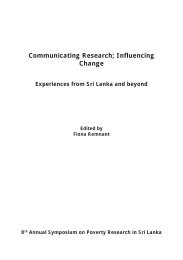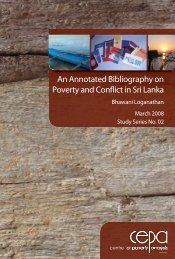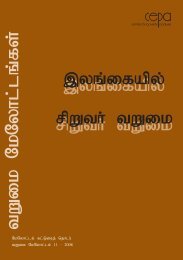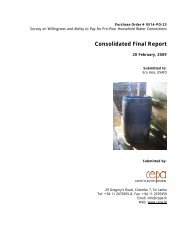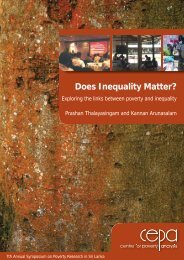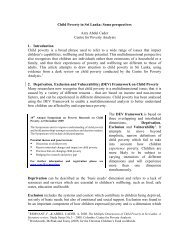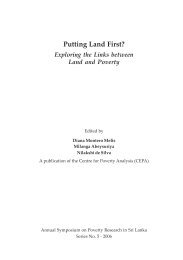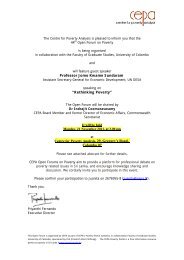Involuntary Displacement and Resettlement â Policy and ... - CEPA
Involuntary Displacement and Resettlement â Policy and ... - CEPA
Involuntary Displacement and Resettlement â Policy and ... - CEPA
- No tags were found...
Create successful ePaper yourself
Turn your PDF publications into a flip-book with our unique Google optimized e-Paper software.
By overcoming the data collection challenges our work has led to a significant<strong>and</strong> unique improvement in the quality of data used in the relevantliterature 5 .There are four other features which make this study unique within theliterature on the conflict in Sri Lanka in particular, <strong>and</strong> within the discipline ofrefugee studies in general. Firstly, no previous study has been able toquantify the livelihood impacts of displacement on people forcefully displacedby conflict. This is due mainly to the lack of data. Secondly, only a few studiesfocus exclusively on the economic impact of CID (Amirthalingam <strong>and</strong>Lakshman forthcoming, is an exception). It is alleged that economists havecontributed far less to displacement literature even though their contributionis highly sought after (Cernea 1995; Cernea 2007). Though Cernea’s concernis primarily in relation to development induced displacement (DID), this lackof economic analysis <strong>and</strong> interpretation is also felt in relation to CID. Thirdly,the richness of our data enables us to segregate the overall livelihoodimpacts into various sub-components. These sub-components are clearlyidentified as capabilities, tangible assets <strong>and</strong> intangible assets by Chambers<strong>and</strong> Conway (1992: 8). However, we believe that Korf’s (2004: 277)categorization is more suitable for our purposes. He identifies six forms oflivelihood endowments − natural, physical, human, social, political, <strong>and</strong>financial − available to an individual. Whenever it was possible to measurethe impact of displacement on these livelihood endowments, we have doneso. That has enabled us to compare across these various endowments, whichexercise has revealed that the various endowments react to displacementdifferently. This is something that researchers have not been able to quantifyuntil now.Fourthly <strong>and</strong> finally, this work <strong>and</strong> the approach we use provide an elegantmeans of operationalising some of the ideas proposed in the GuidingPrinciples. Here, using our empirical evidence we have been able to augmentCernea’s (1995) resettler’s income curve to the case of CID.The paper is organised as follows: Section 2 introduces a new tool to examineCID incomes. Section 3 outlines the Sri Lankan experience in internal5We believe that we got the proper balance of insider <strong>and</strong> outsider researchers with Tamillanguage skills, some exposure to firsth<strong>and</strong> displacement experience, <strong>and</strong> regional navigationalknowledge (both Sampur <strong>and</strong> Batticaloa). This research team therefore had a natural capacityto predict likely ethical issues, <strong>and</strong> security risks faced by the research participants (seeGoodh<strong>and</strong> 2000).60



